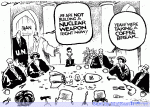As the protests in Iran dominated international news in early January, an editor of Grazia asked Farian Sabahi, a historian who specializes in Iran and the Middle East, to comment on the protests ravaging her country.
Sabahi penned a piece that focused on the role of women in the demonstrations, underlining that they wanted the same thing as male demonstrators — more jobs and more political rights. She said that even though the women’s question remains an important one in Iran, the uprising was not directly triggered by the compulsory veil, or hijab. She also referred to the “white veil” photo in the media that showed an unnamed woman stood alone without her hijab, silently waving a white scarf. Sabahi explained that the image did not come during the recent demonstrations, but was taken a day before they started, as part of a movement known as White Wednesday that started months ago. Her commentary underlined that hijab has no role in the current protests, which rather stem from economic as well as political grievances.
When the article came out, however, Sabahi was surprised to see that its contents had been altered — including the caption that identified the photo as belonging to the White Wednesday movement. The writer thought that all the changes twisted her viewpoint and portrayed women’s desire to take off the hijab as the engine of the current upheavals. “I wrote an email to the editor-in-chief and she quickly apologized,” Sabahi told Al-Monitor. She also posted a correction on Facebook. But though it was taken offline, the erroneous article remained in circulation in newsstands.
For Sabahi and other academics, this event encapsulates the caricaturization of the veil and the women’s movement in the Iranian demonstrations. As local and politically outspoken women are a Western media clickbait favorite, women’s images and statements are frequently used in the stories about protests even if few women are present. The veil, even when it is a minor player, seems to have become a reductive symbol of women’s participation in wider movements.
According to Mahnaz Shirali, a researcher at Sciences Po Paris and author of “The Mystery of Contemporary Iran,” the coverage of the Iranian protests in European and American media has indeed often been “partial and sometimes superficial.”
“It’s true that the question of the veil is important and a symbol of the regime’s repression, but Iranian society’s — and women’s — demands shouldn’t be merely reduced to the veil as a main reason for the demonstrations,” she told Al-Monitor.
“Women are currently complaining about rising prices, corruption, lack of transparency. Their complaints are on the same issues men are worried about,” Sabahi said. Even if many women joined the movement in the streets, the veil “is not their main focus,” she added.
Ali Fathollah-Nejad, visiting fellow at the Brookings Doha Center, explained to Al-Monitor that although the majority of protesters are young working-class men, the grievances expressed throughout the protests and their slogans “transcend boundaries of gender and even class.”
Although most experts on Iran consulted for this article do not consider the compulsory hijab one of the reasons in the protests, they do nevertheless consider it a crucial driver of Iranian women’s resistance.
Iranian women’s rights activist Masih Alinejad launched the famous My Stealthy Freedom (MSF) campaign against compulsory hijab in 2014. MSF is currently the largest and best known Iranian online protest against compulsory hijab. Through it, Iranian women speak out not only against forced veiling but also “the unfairness of Iran’s rules when it comes to women’s rights from employment to marriage and divorce, from traveling to attending sports stadiums and so on,” Alinejad told Al-Monitor.
Alinejad explained how the movement she founded has become more visible in the streets since May through the White Wednesday campaigns. She said the continuous presence of MSF and White Wednesday have contributed to empowering Iranian women to become more aware of their social role. “I received many videos from women who had participated in the White Wednesday campaign who were participating in the [current] protests and were sending me clips,” she said.
Other women in different cities across Iran have followed the example of the young woman who was photographed waving her white scarf. “I couldn’t participate in the recent protests due to health reasons, but I saw the video of that brave girl without hijab waving it like a white flag. I decided to do something to support her and posted some pictures on Instagram without my hijab, showing my support,” said Shaparak Shajari, a 42-year-old social media activist who participated in the 2009 protests. “Compulsory hijab is not the only reason we women want a change. We want to regain our dignity,” she told Al-Monitor.
The Dec. 27 photo and video of the young woman calmly waving her white shawl in the middle of the busy Enghelab Avenue in Mashad, the second most populous city in Iran, went viral. “As the protests spread, many Iranian activists online were inspired by the nonviolent protest of the lone girl,” explained Alinejad. “Thousands of Iranians changed their profile picture to a one depicting her act. Her gesture was seen as a symbol of resistance. Her protest caught the imagination of Iranian women and men, feminists and non-feminists.”
Read more: http://www.al-monitor.com/pulse/originals/2018/01/veils-role-in-iran-protests.html#ixzz54eW3kkxC










